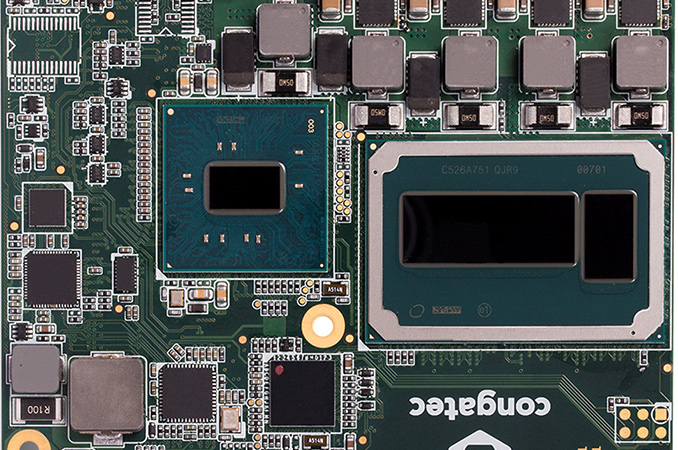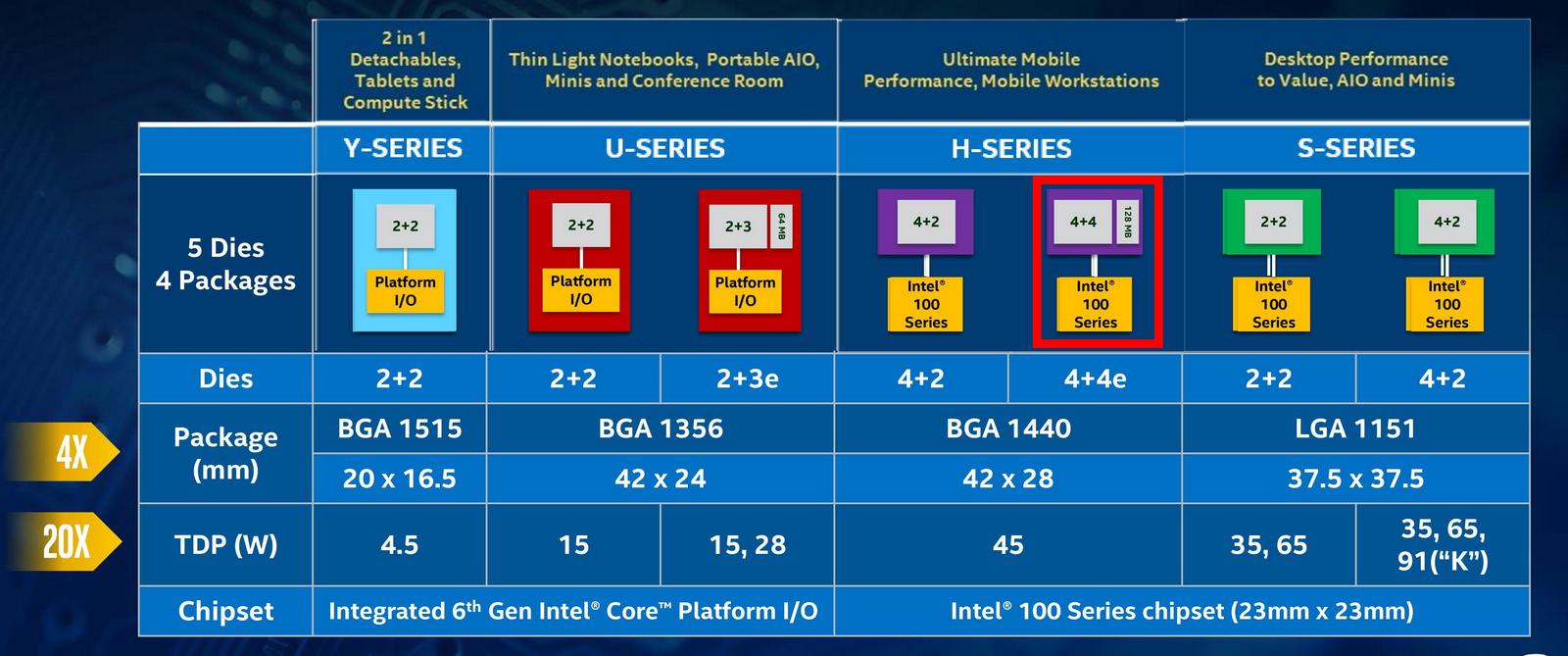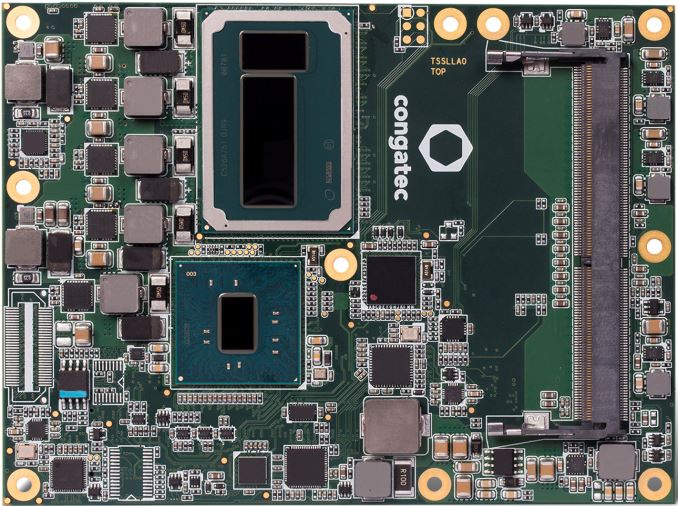Intel Adds Crystal Well-based Skylake-R Processors: 65W with 128MB eDRAM
by Anton Shilov on May 2, 2016 4:30 PM EST
Intel has added three new microprocessors for embedded and highly-integrated applications into its lineup. The new CPUs are based on the Skylake microarchitecture and feature high-performance integrated graphics cores with an added eDRAM cache called Crystal Well. The new products should offer high performance in memory bandwidth applications due to Skylake’s updated 2nd generation cache architecture.

In red is the 4+4e die with 128MB eDRAM
The chips that Intel has added to its price list are the Core i7-6785R, the Core i5-6685R, and the Core i5-6585R. The new processors are designed to fit in all-in-one PCs, small form-factor and other types of highly-integrated PCs that can satisfy the 65W TDP over the mobile Crystal Well variants that run at 45W. The new desktop chips from Intel are based on the Skylake-H silicon in its most advanced configuration: with four general-purpose cores as well as the GT4e integrated graphics. Not all the specifications of the processors are known at this point, but we are talking about quad-core processors with Generation 9 Iris Pro graphics and 72 execution units (as well as 128 MB of eDRAM), a dual-channel DDR4-2133 memory controller, a PCI Express 3.0 interface and three display outputs. The power consumption of Intel’s new embedded products for desktops does not exceed 65 W, which is typical for R-series offerings, and offer a potential upgrade path by OEMs for any equivalent systems that used an equivalent Broadwell-based R-series processor.
Intel unveiled its Skylake-H silicon in its full glory earlier this year when it released its mobile Xeon E3 v5 processors with the Iris Pro Graphics P580.
Several makers of industrial computer modules (such as Congatec) already use chips like the Intel Xeon E3-1515M v5 for their products, which is why we know what they look like. The die of the Skylake-H processor looks rather long and the lion’s portion of its transistor budget was spent on the mammoth iGPU. The extra on package die is the eDRAM, and the silicon underneath the CPU is the chipset (it's the Y/U series CPUs that have integrated chipsets).
| Comparison of Intel's Embedded CPUs | |||||||||
| i7-6785R | i5-6685R | i5-6585R | i7-5775R | i5-5675R | i5-5575R | ||||
| Microarchitecture | Skylake | Broadwell | |||||||
| Cores/Threads | 4 / 8 | 4 / 4 | 4 / 4 | 4 / 8 | 4 / 4 | 4 / 4 | |||
| L2 Cache | 1 MB (256 KB × 4) | ||||||||
| L3 Cache | 8 MB | 6 MB | 6 MB | 4 MB | |||||
| eDRAM | 128 MB | 128 MB | |||||||
| CPU Frequency | default | 3.30 GHz | 3.20 GHz | 2.80 GHz | 3.30 GHz | 3.10 GHz | 2.80 GHz | ||
| maximum | 3.90 GHz | 3.80 GHz | 3.60 GHz | 3.80 GHz | 3.60 GHz | 3.30 GHz | |||
| GPU | Iris Pro 580 | Iris Pro 6200 | |||||||
| EUs | 72 | 48 | |||||||
| TDP | 65 W | 65 W | |||||||
| GPU Frequency | 350 MHz to 1150/1150/1100 MHz | 300 MHz to 1150/1100/1050 MHz | |||||||
| DRAM Support | DDR4-2133/1866 DDR3L-1600/1333 |
- DDR3L-1866/1600/1333 |
|||||||
| Packaging | FCBGA1440 | FCBGA1364 | |||||||
| Process Technology | 14 nm | ||||||||
| Price | $370 | $288 | $255 | $348 | $265 | $244 | |||
The new parts feature higher clock rates compared to the Broadwell processors, although slightly lower than their K series counterparts. The processors have a number of important architectural improvements which will affect the performance of these CPUs in real-world applications. It is interesting to note that Intel retained the full L3 cache size in its new R-series CPUs: in the Broadwell models part of the L3 was used for eDRAM tags, reducing their capacity by 2 MB, but the new Skylake parts are now in line with their i7 and i5 naming due to the way the eDRAM is implemented. This means that the i7-6785R has 8 MB of L3, similar to the i7-6700K, and the i5-6685R/6585R has 6 MB of L3, similar to the i5-6600K.
Intel’s Skylake processors feature an upgraded microarchitecture with better parallelism and improved IPC, which means better performance almost across-the-board. An important capability of Skylake is its Speed Shift technology, which can quickly increase frequency for a short amount of time in a bid to rapidly perform an operation (~1-3 milliseconds rather than 30-100 without Speed Shift), thus providing better user experience and ultimately saving power. Intel’s Speed Shift requires support by the operating system and right now Microsoft’s Windows 10 can take advantage of the technology in a bid to improve its responsiveness.
Another important aspect of Intel’s Skylake CPUs with high-end iGPUs is their eDRAM, which means the processors also gain the code name 'Crystal Well'. The eDRAM for Skylake is different to that found in previous Crystal Well implementations: in the last generation, the eDRAM acted as a victim cache to the L3 cache, meaning that evicted cache lines from L3 would add up in the eDRAM and be quick for re-reading without having to access main memory. The downside to this is that data could not end up in eDRAM without being used first, giving initial data read latencies the same performance as previous processors. Ultimately this is still good for graphics and gaming, where textures are re-read from memory frequently. The new arrangement for the eDRAM in these Skylake processors has placed the eDRAM in a different part of the chain, between the System Agent and the DDR memory. This means that the eDRAM acts as a DRAM buffer, with 50 GBps bandwidth in each direction to the LLC, but is also accessible for early reads/writes by any device that needs memory access through the system agent (i.e. anything through PCIe). Previously this was not possible, but now it means that Skylake's eDRAM implementation should offer a speedup in many more scenarios that before.
The final noteworthy improvement of the Skylake processors compared to previous-generation offerings is revamped graphics core as well as increased amount of execution units. Based on our findings last year, real-world performance of Intel's high-end Iris Pro 6200 graphics core (Broadwell’s top iGPU) is higher than that of entry-level discrete graphics cards. Meanwhile, the highest-performing GT4e graphics core of Intel Skylake contains 72 EUs, up from 48 in the case of the Broadwell. Compute performance of Intel's contemporary top-of-the-range iGPU (Iris Pro 580) is around 1.1 TFLOPS depending on its frequency, so, this one should be tangibly faster than its predecessor. Last, but not least, Skylake’s iGPU has a revamped multimedia engine, which supports hardware decoding and encoding of UHD videos using HEVC or VP9 codecs.
Intel’s new Core i7-6785R, Core i5-6685R, and Core i5-6585R are already available at a tray price of $370, $288 and $255 respectively. Partners of the chipmaker will likely use the new processors to build their new systems in the coming months.
Image Sources: Congatec, Intel's IDF presentations.
Source: Intel's Price List (via a reader)












67 Comments
View All Comments
freeskier93 - Monday, May 2, 2016 - link
Maybe theoretically possible in a current 15" MBP variation with no discrete graphics, but it incredibly unlikely, especially with a rumored redesign. These are likely to show up in new iMacs though.ravyne - Monday, May 2, 2016 - link
45w is within the range of the larger MBP's TDP. I would think, even, that they could manage it in the smaller Pro as the "high-end" configuration -- other, smaller chassis managed higher combined CPU/discrete GPU TDPs, its just a matter of the cooling solution.I'm hoping, personally, that this will be the case in the higher-spec'd 13" Pro, and that this will be the baseline (or minor upgrade) of the 15" Pro (where you get a discrete GPU in the high-end one). Historically, the 13" Pro has been a dual-core + HT machine, but frankly that's overdue to change. I'm also hoping they'll opt for the Mobile Xeon version of these chips, with ECC ram standard.
ravyne - Monday, May 2, 2016 - link
I believe these chips would also have configurable TDP down -- which I believe would be down to 35w in this case, and that's more than doable in a 13" chassis. It'd throttle itself, so you'd get less performance out of the 13", but that's still a lot of wallop in something so svelte.This chip is the same config as the chip in the Skull Canyon NUC, and that'll play most contemporary games* at 1080p, 60FPS on medium/medium-high settings. The 72 EUs is 50% more than what's in the 3e configuration, and the eDRAM gives rather a lot of low-latency bandwidth.
*Those that don't routinely showcase as graphics benchmark showcases.
zepi - Tuesday, May 3, 2016 - link
For 13" laptops Intel offers a 28W TDP model with slightly reduced edram:http://ark.intel.com/products/91167/Intel-Core-i7-...
For some reason, no PC manufacturer seems to use this. The 15W TDP model is afaik used in one high-end version of XPS 13 and in expensive Surface 4 Pro variants.
http://ark.intel.com/products/91163/Intel-Core-i7-...
If Apple is just doing a little internal update to their 13" model, the first one seems like a good candidate to be found in at least the BTO models. If they do more complete redesign, who knows what they'll pick.
extide - Tuesday, May 3, 2016 - link
Yeah those 28W ones are the 2+3e parts he was talking about. MUCH lower end chip, only 2 cores instead of 4, and only 48 instead of 72 EU's on the iGPU, and 64 instead of 128MB of eDRAM.8steve8 - Wednesday, May 4, 2016 - link
28W CPUs are used by apple in their rMBP 13.and a few others (asus, i believe)...
Everyone else uses 15W for everything... even most intel NUCs use 15W CPUs.
I hope intel makes a better version of the skull canyon NUC with this 65W CPU instead of the 45W CPU they used. We will accept a bit of height to fit a better cooler in there.
smilingcrow - Tuesday, May 3, 2016 - link
Purely at the level of the CPU these are too high as 35W - 47W is the usual range for laptop quads outside of the odd Xtreme edition or maybe workstation mobile CPU.If you look at the total TDP of a CPU + GPU then 65W is common although not sure what the actual max is for MacBook Pros.
CharonPDX - Thursday, May 12, 2016 - link
Yes, but it's based on a 45W chip that is within range for the MBP. In the second picture, the red-highlighted version is actually the 45W "mobile" version - this new one is higher wattage.This is a chip that is probably destined for the 21" iMac. (Hopefully the 27" retains the socketed CPU and discrete graphics.)
cmasontaylor - Thursday, May 19, 2016 - link
These are far, far outside the MBP's CPU's TDP range. Apple would never consider them for a laptop. They'd be a great choice for an iMac refresh, potentially, but then, since Apple typically puts "full-on" desktop-class CPUs in those units, something like this would be a step down if anything. The good news is, there are indeed 45W-class CPUs in Skylake that have Iris Pro GPUs, something Apple will certainly want to put into their entry level 15" models.madwolfa - Monday, May 2, 2016 - link
Come on, AnandTech. Full screen pop up ads? I'd have to reconsider turning off my AdBlock here.